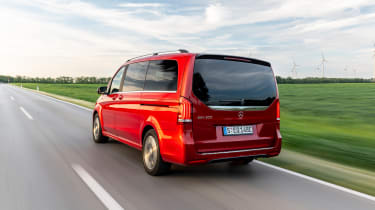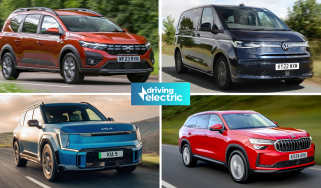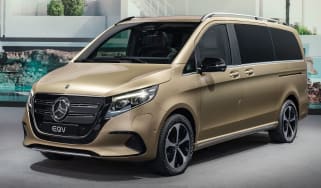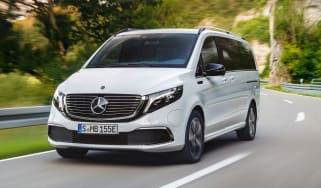Mercedes EQV review
The Mercedes EQV builds on the basis of the smart V-Class people carrier to offer VIP transport with silent and refined electric power
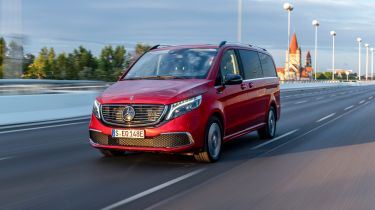
Pros
- As big as electric cars get
- Seating for up to seven
- Very quiet on the move
Cons
- Expensive
- Ride can feel bouncy
- Range isn't that impressive
| Car type | Electric range | Wallbox charge time | Rapid charge time |
|---|---|---|---|
| Electric | 211-213 miles | 14hrs 30mins (0-100%, 7.4kW) | 45mins (10-80%, 110kW) |
The Mercedes EQV is the first all-electric MPV from the German brand, and it might look a little familiar. That’s because it’s based partly on the Mercedes V-Class, a posh people carrier known for its luxury and quality inside – yet both are also related to the hard-working Vito van.
It’s this that may put off a number of potential customers, though a quick seat inside should put any quality concerns to rest. The interior has an upmarket feel, and while it doesn’t get the dazzling Hyperscreen layout from the latest Mercedes EQS, connectivity and equipment is otherwise on point.
There are three versions to choose from: Sport, Sport Premium and Sport Premium Plus. Sport is available in either a 2-2-3 or 2-3-2 seating formation, while Premium and Premium Plus cars both use a 2-2-3 layout with a fold-out table system for middle-row passengers.
All EQV models also get a good level of standard equipment – much as you'd expect from such an expensive vehicle. Highlights include 17-inch alloy wheels, LED lights front and rear, comfort suspension and electrically-folding door mirrors. Inside there’s heated front seats, plus automatic climate control and ebony wood-effect trim, as well as a 10.25-inch screen for the infotainment system.
Sport Premium bolsters the standard kit list with privacy glass, electrically-adjustable front seats and some different trim, plus 360-degree parking cameras, Apple CarPlay and Android Auto. Base cars don’t get this basic smartphone tech as standard (it’s a £299 option) despite costing north of £80,000.
The flagship Sport Premium Plus costs over £7,500 more than the base car but brings 18-inch wheels and air suspension for a more composed ride, plus a Burmester surround sound system with 15 speakers.
The electric motor and electrical parts sit where the diesel engine would in a V-Class, while the 90kWh battery is mounted under the floor. There’s none of the diesel’s annoying clatter from the 201bhp electric motor, though – instead, you get an even more relaxing experience. Performance is good, too: officially it takes 12.1 seconds to hit 62mph but the car feels surprisingly fast in a straight line. We’ll caveat that with the fact we’ve not driven the EQV with a full cohort of passengers; it may feel a little more laborious with all of the seven seats occupied.
Its range of up to 213 miles should be enough for both business and private buyers who mainly drive in town, but motorway journeys will hammer efficiency. The same is true of the EQV’s main rivals, of course.
Speaking of which, there aren’t that many vehicles that compete in this area of the market. There are less premium models like the Citroen e-SpaceTourer, Peugeot e-Traveller and Vauxhall Vivaro-e Life, as well as seven-seat SUVs – like the Tesla Model X and Merc’s own EQS SUV – that may tickle your fancy if outright space isn’t an absolute necessity.
When there are no passengers on board, the EQV is a little bouncy and soft, but it’s comfy enough. We've not yet tried a top-spec car with its full air suspension setup, but it seems this is the model to go for if you want maximum comfort and can stomach the high price. Other aspects of the driving experience, such as the light steering mean the EQV encourages you to take it easy at all times.
The EQV is based on a longer-wheelbase version of the Vito van, so some may have to get used to the feeling of driving a vehicle that's just over 5.3 metres long and 2.2 metres wide including mirrors. A 360-degree parking camera is a godsend in tighter spots like multi-storey car parks, but only comes as standard on the Sport Premium and Premium Plus models. All get parking sensors, however, so there's at least a basic level of assistance.
The EQV is a fantastic way to travel in comfort, as it glides around in serene silence both at low speeds around town and on the motorway. It's a relaxing long-distance car, too, while the 110kW DC rapid charging capacity means you can make swift top-ups on such trips: a 10-80% charge from a compatible public rapid charger will take around 45 minutes. That’s some way off the lofty charge rates of Merc’s newer EVs, but still competitive in this area of the market.
Maximum AC charging speed is 11kW; if you have access to three-phase electrics (most domestic properties do not) then you’ll be able to recharge in around 10 hours. A more conventional 7kW home wallbox at home will take an extra four hours or so.
Overall, the EQV makes a lot of sense as a company car that doubles up as transport for a large family, or as a zero-emissions alternative for executive transport firms. But cheaper alternatives have started to appear, and many will be tempted by the ever-expanding choice of seven-seat SUVs.

